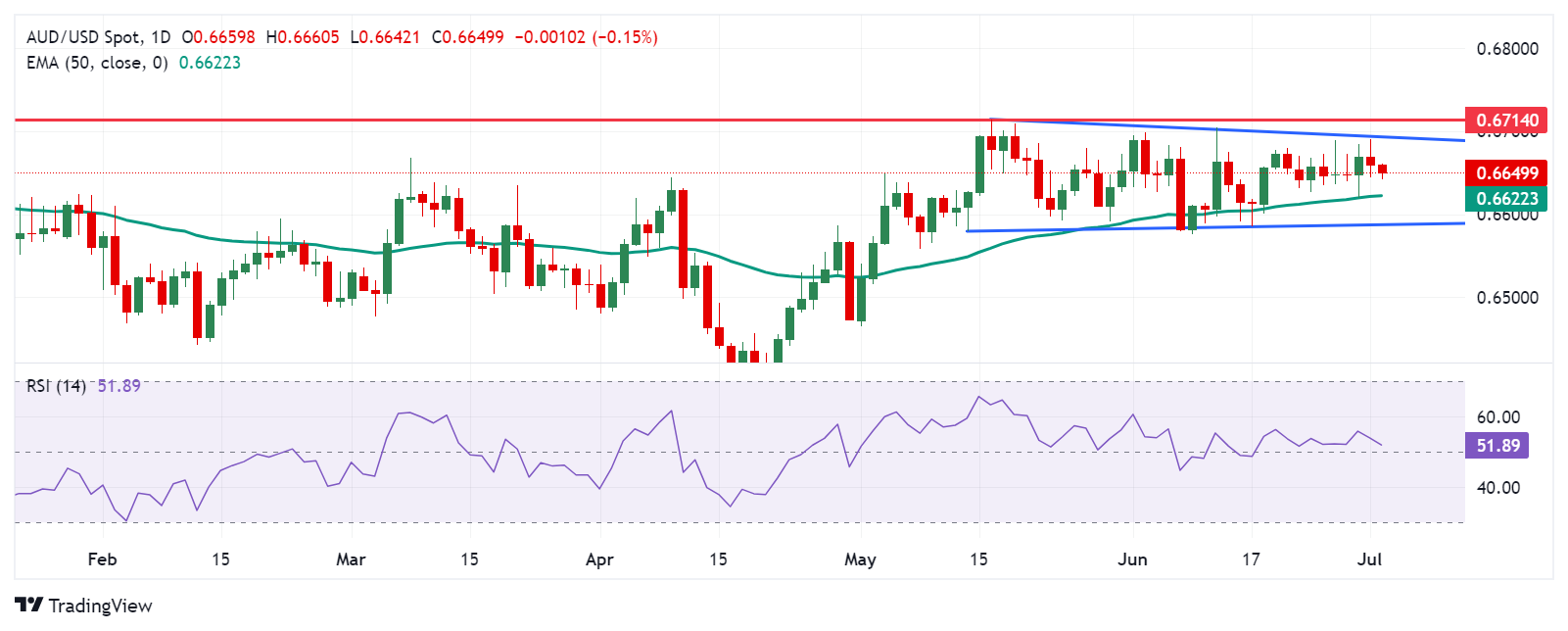- The Australian Dollar loses ground as the RBA Index of Commodity Prices fell by 4.1% YoY in June.
- RBA Minutes emphasizes the need to remain vigilant as data suggested an upside risk for May's CPI.
- The US Dollar appreciates due to the higher US Treasury yields amid heightened expectations of the Fed reducing rates in 2024.
The Australian Dollar (AUD) extends its losses for the second successive day on Tuesday. This downturn could be attributed to the Reserve Bank of Australia's (RBA) Index of Commodity Prices, which fell by 4.1% year-on-year in June, following an upwardly revised 6.0% decline in the previous month. The June decline marks the mildest deflation in sixteen consecutive months.
The Minutes of the Reserve Bank of Australia’s (RBA) June monetary policy meeting, released Tuesday, indicated that the "board judged the case for holding rates steady stronger than hiking." The board emphasized the need to remain vigilant to upside risks to inflation, noting that data suggested an upside risk for May's Consumer Price Index (CPI).
The US Dollar (USD) appreciates due to the advance in the US Treasury yields. The Greenback may limit its upside due to the heightened expectations of the US Federal Reserve’s (Fed) deducting interest rates in 2024. The speech by Federal Reserve (Fed) Chairman Jerome Powell will be in the spotlight on Tuesday.
Daily Digest Market Movers: Australian Dollar declines due to softer Index of Commodity Prices
- The Melbourne Institute's Monthly Inflation Gauge has heightened concerns that the RBA might raise interest rates again in August. The gauge increased by 0.3% in June, maintaining the same pace as in May, marking the fourth consecutive month of rises and remaining at the highest since January.
- Chinese state media outlet Securities Daily quotes the chief economist at CITIC Securities, suggesting that the People's Bank of China (PBOC) might consider measures like reducing the reserve requirement ratio (RRR) to inject liquidity into the market. Any potential economic shift in China could notably influence the Australian Dollar (AUD), given the close trade ties between the two nations.
- The Judo Bank Australia Manufacturing PMI dropped for the fifth consecutive month to 47.2 in June from 49.7 in May. This decline is the fastest deterioration since May 2020.
- The US Manufacturing Purchasing Managers Index (PMI) for June fell to 48.5, down from 48.7 in May. This figure was weaker than the expected 49.1, as reported on Monday.
- On Friday, the Federal Reserve Bank of San Francisco President Mary Daly said that monetary policy is working. Still, it’s too early to tell when it will be appropriate to cut the interest rate. Daly stated, "If inflation stays sticky or comes down slowly, rates would need to be higher for longer,” per Reuters.
- The Reserve Bank of Australia’s (RBA) Deputy Governor Andrew Hauser. Hauser said it would be a “bad mistake” to formulate policy in response to a single inflation report. He emphasized that there is still a suite of economic data to come that will require detailed analysis, per Bloomberg.
Technical Analysis: Australian Dollar hovers around 0.6650
The Australian Dollar trades around 0.6640 on Tuesday. The analysis of the daily chart shows a neutral bias for the AUD/USD pair, which is consolidating within a rectangle formation. The 14-day Relative Strength Index (RSI) is at 50, also indicating neutral momentum. Future movements may provide a clearer directional trend.
The AUD/USD pair may face resistance near the upper boundary of the rectangle formation at around 0.6690, followed by the psychological level of 0.6700. Additional resistance is located at 0.6714, the highest level since January.
On the downside, the AUD/USD pair could find support near the 50-day Exponential Moving Average (EMA) at 0.6622. A break below this level could lead the pair to test the lower boundary of the rectangle formation near 0.6585.
AUD/USD: Daily Chart
(This story was corrected on July 3 at 08:50 GMT to say, in the third paragraph, that the Greenback may limit its upside...)
Australian Dollar PRICE Today
The table below shows the percentage change of Australian Dollar (AUD) against listed major currencies today. Australian Dollar was the weakest against the US Dollar.
| USD | EUR | GBP | JPY | CAD | AUD | NZD | CHF | |
|---|---|---|---|---|---|---|---|---|
| USD | 0.06% | 0.08% | 0.13% | 0.06% | 0.25% | 0.36% | 0.18% | |
| EUR | -0.06% | 0.03% | 0.09% | -0.01% | 0.19% | 0.27% | 0.10% | |
| GBP | -0.08% | -0.03% | 0.06% | -0.01% | 0.15% | 0.25% | 0.06% | |
| JPY | -0.13% | -0.09% | -0.06% | -0.08% | 0.13% | 0.20% | 0.00% | |
| CAD | -0.06% | 0.00% | 0.01% | 0.08% | 0.19% | 0.30% | 0.09% | |
| AUD | -0.25% | -0.19% | -0.15% | -0.13% | -0.19% | 0.10% | -0.12% | |
| NZD | -0.36% | -0.27% | -0.25% | -0.20% | -0.30% | -0.10% | -0.21% | |
| CHF | -0.18% | -0.10% | -0.06% | -0.01% | -0.09% | 0.12% | 0.21% |
The heat map shows percentage changes of major currencies against each other. The base currency is picked from the left column, while the quote currency is picked from the top row. For example, if you pick the Australian Dollar from the left column and move along the horizontal line to the US Dollar, the percentage change displayed in the box will represent AUD (base)/USD (quote).
Economic Indicator
AiG Industry Index
The AiG Industry Index, released on a monthly basis by the Australian Industry Group, is a leading indicator gauging private-business activity in Australia. This indicator integrates the different sub-indexes calculated by the AiG, including the manufacturing, construction, and services sectors – industries that together account for 36% of the Australian economy. The Australian Industry Index is based on monthly surveys from a national sample of Australian businesses. A positive reading indicates that activity is expanding; negative indicates contraction. The distance from zero indicates the strength of the expansion or decline. A positive reading tends to be a bullish sign for the Australian Dollar (AUD). Meanwhile, a negative reading is seen as bearish for AUD.
Read more.Next release: Tue Jul 02, 2024 23:00
Frequency: Monthly
Consensus: -
Previous: -40.3
Source: Australian Industry Group
Information on these pages contains forward-looking statements that involve risks and uncertainties. Markets and instruments profiled on this page are for informational purposes only and should not in any way come across as a recommendation to buy or sell in these assets. You should do your own thorough research before making any investment decisions. FXStreet does not in any way guarantee that this information is free from mistakes, errors, or material misstatements. It also does not guarantee that this information is of a timely nature. Investing in Open Markets involves a great deal of risk, including the loss of all or a portion of your investment, as well as emotional distress. All risks, losses and costs associated with investing, including total loss of principal, are your responsibility. The views and opinions expressed in this article are those of the authors and do not necessarily reflect the official policy or position of FXStreet nor its advertisers. The author will not be held responsible for information that is found at the end of links posted on this page.
If not otherwise explicitly mentioned in the body of the article, at the time of writing, the author has no position in any stock mentioned in this article and no business relationship with any company mentioned. The author has not received compensation for writing this article, other than from FXStreet.
FXStreet and the author do not provide personalized recommendations. The author makes no representations as to the accuracy, completeness, or suitability of this information. FXStreet and the author will not be liable for any errors, omissions or any losses, injuries or damages arising from this information and its display or use. Errors and omissions excepted.
The author and FXStreet are not registered investment advisors and nothing in this article is intended to be investment advice.
Recommended content
Editors’ Picks

Australian Dollar appreciates despite stronger US Dollar, PMI awaited
The Australian Dollar (AUD) continues to strengthen against the US Dollar (USD) following the release of mixed Judo Bank Purchasing Managers' Index (PMI) data from Australia on Friday. The AUD also benefits from a hawkish outlook by the Reserve Bank of Australia (RBA) regarding future interest rate decisions.

Japanese Yen remains on the front foot against USD, bulls seem non-committed
The Japanese Yen (JPY) attracts some buyers for the second straight day on Friday amid reviving bets for more interest rate hikes by the Bank of Japan (BoJ), though it lacks any follow-through.

Gold advances to near two-week high, eyes $2,700 on geopolitical tensions
Gold price (XAU/USD) prolongs its uptrend for the fifth consecutive day on Friday and climbs to a nearly two-week top, around the $2,690-2,691 area during the Asian session. Intensifying Russia-Ukraine tensions force investors to take refuge in traditional safe-haven assets and turn out to be a key factor underpinning the precious metal.

Ethereum Price Forecast: ETH open interest surge to all-time high after recent price rally
Ethereum (ETH) is trading near $3,350, experiencing an 10% increase on Thursday. This price surge is attributed to strong bullish sentiment among derivatives traders, driving its open interest above $20 billion for the first time.

A new horizon: The economic outlook in a new leadership and policy era
The economic aftershocks of the COVID pandemic, which have dominated the economic landscape over the past few years, are steadily dissipating. These pandemic-induced economic effects are set to be largely supplanted by economic policy changes that are on the horizon in the United States.

Best Forex Brokers with Low Spreads
VERIFIED Low spreads are crucial for reducing trading costs. Explore top Forex brokers offering competitive spreads and high leverage. Compare options for EUR/USD, GBP/USD, USD/JPY, and Gold.
